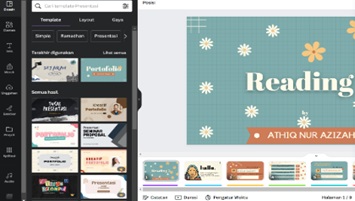Development of Teaching Materials Using Canva Application for Students' Reading Comprehension
Keywords:
Canva Application, Students' Reading Comprehension, Teaching MaterialsAbstract
Developing a Canva media application for students' reading comprehension can overcome several difficulties and balance learning. It is important to apply Canva for reading among students because with the help of Canva media it has several benefits, including increasing motivation and interest in learning by emphasizing topics related to problem solving. Another factor in learning that must be considered is student learning outcomes and learning motivation. This type of research is study and creation. Instead of testing hypotheses, research and development (R&D) produces products. This reseach used 4D model, namly defining, design, develop, and describe. The results of this research showed that (1) Learning to make comprehensive reading presentations using Canva received a positive response from students. To find out student responses regarding using Canva as a comprehensive reading learning medium, we distributed a questionnaire. (2) Learning comprehensive reading is a challenge for many students, especially English students in semester 4. (3) Improving comprehensive reading skills requires a creative and innovative approach. In this case, the Canva application has proven to be a very useful tool in facilitating such learning in an engaging and interactive way
Downloads

Published
How to Cite
Issue
Section
License
Copyright (c) 2024 Jurnal Penelitian Tindakan Kelas

This work is licensed under a Creative Commons Attribution-ShareAlike 4.0 International License.

 Universitas Ma’arif Lampung, Indonesia
Universitas Ma’arif Lampung, Indonesia


















